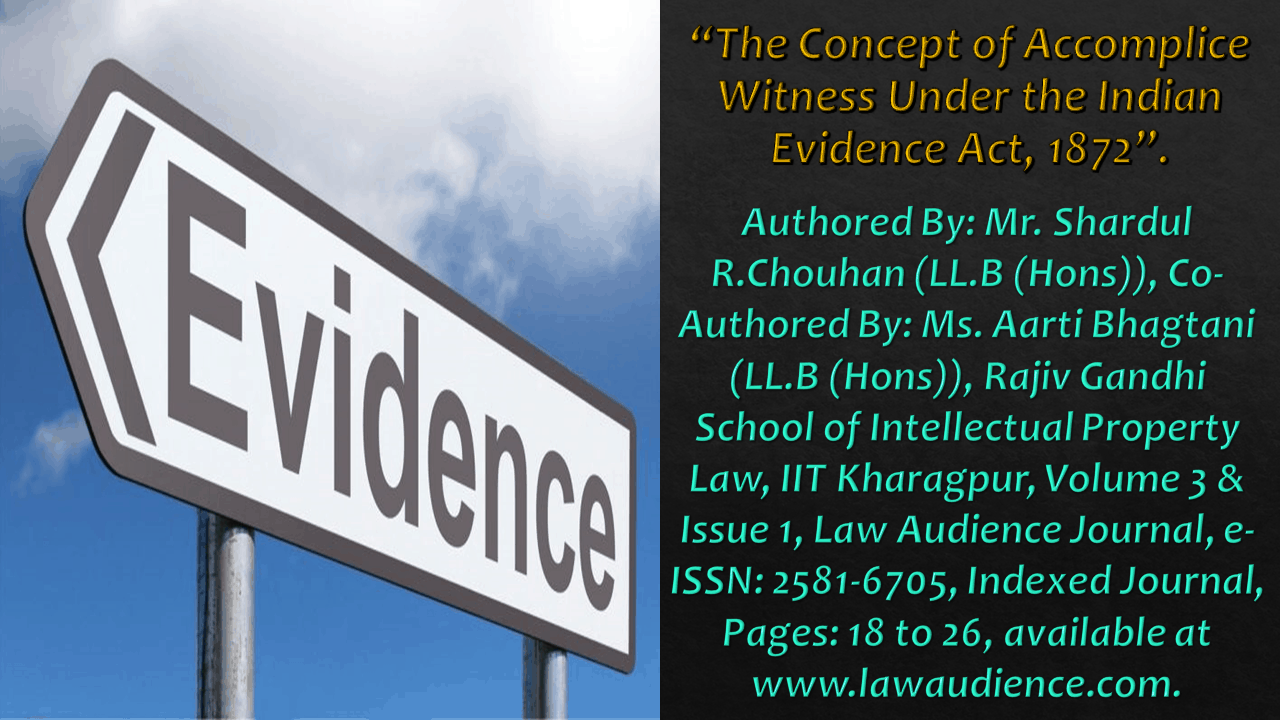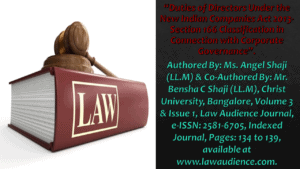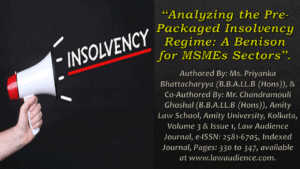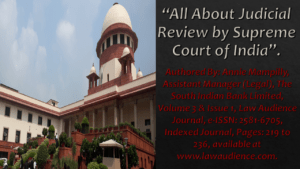Click here to download the full paper (PDF)
Authored By: Mr. Shardul R.Chouhan (LL.B (Hons)), & Co-Authored By: Ms. Aarti Bhagtani (LL.B (Hons)), Rajiv Gandhi School of Intellectual Property Law, IIT Kharagpur,
Click here for Copyright Policy.
I. INTRODUCTION:
“An accomplice is a person who has taken part in the commission of a crime-a guilty associate or partner in crime. When an offence is committed by more than one person in concert, everyone participating in its commission is an accomplice. He is called an approver if he is granted a pardon under Sec.306 of the CrPC,1973.
An accomplice by becoming an approver becomes a prosecution witness. When he appears as a witness for the prosecution against the accused person with whom he acted together in the commission of the crime, the question arises as to what is the value of the evidence of a former criminal turned witness”.
II. CONCEPT OF ACCOMPLICE WITNESS UNDER THE INDIAN EVIDENCE ACT:
Section 133 Accomplice:
An accomplice shall be a competent witness against an accused person; and a conviction is not illegal merely because it proceeds upon the uncorroborated testimony of an accomplice.
Section 114 (b):
That an accomplice is unworthy of credit, unless he is corroborated in material particulars.
However, Sec. 114 also gives two instances when this does not apply as in, illustration (b)— A, a person of the highest character, is tried for causing a man’s death by an act of negligence in arranging certain machinery. B, a person of equally good character, who also took part in the arrangement, describes precisely what was done, and admits and explains the common carelessness of A and himself.
The other instance is -A crime is committed by several persons. A, B and C, three of the criminals, are captured on the spot and kept apart from each other. Each gives an account of the crime implicating D, and the accounts corroborate each other in such a manner as to render previous concert highly improbable.
There is no antithesis between Sec.133 and Sec.114 because the illustration only says that the court ‘may’ presume a certain state of affairs. It does not seek to raise a conclusive presumption. Sec.133 is a clear authorisation to the courts to convict on the corroborated testimony of an accomplice, but since such a witness, being criminal himself, may not always be trustworthy, the courts are guided by the illustration appended to Sec.114 that, if it is necessary the court should presume that he is unreliable unless his statements are supported or verified by some independent evidence[1]. Thus, Sec.133 lays down a rule of law. But Sec. 114 illustration (b) lays down a rule of prudence. This rule of prudence has now come to be accepted as a rule of law by judicial legislation both in Indian and English law.
III. EVIDENTIARY VALUE OF AN ACCOMPLICE:
The evidence of an accomplice should stand test of verification at least in main points. This is known as corroboration. There are the following dangers in accepting the ‘uncorroborated testimony’ of an accomplice[2]:
- He is Participes Criminis (a participant in the commission of actual crime), hence evidence comes from a tainted His testimony should not carry the same respect as that of a law-abiding citizen.
- He has been faithless to his companions and may be faithless to the court because he has motive to shift the guilt form himself to his former companions. The paramount danger is that he may weave a story which may implicate even the innocent with the
- If he is an approver, he has been favoured by the state and is therefore likely to favour the State.
These reasons dictate the necessity for corroboration. In fact, an approver’s evidence has to satisfy the double test: (i) his evidence must be reliable;(ii) his evidence should be materially corroborated. ‘Every person who is a competent witness is not a reliable witness and the test of reliability has to be satisfied by an approver all the more before the question of corroboration of his evidence is considered by criminal courts.’
The nature and extent of corroboration of accomplice evidence must necessarily vary with the circumstances of each case, and it is not possible to enunciate any hard and fast rule. But the guiding rules laid down in R. vs. Baskerville[3], are clear beyond controversy. They are:
- It is not necessary that there should be independent confirmation, in every detail, of the crime related by the It is sufficient if there is a confirmation as to a material circumstance of the case.
- The conformation by independent evidence must be of the identity of the accused in relation to the Thus, there must be confirmation that not only has the crime been committed but that the accused committed it.
- The corroboration must be by independent testimony i.e., by some evidence other than that of the accomplice, and therefore, one accomplice cannot corroborate the
- The corroboration need not be by direct evidence that the accused committed the crime; it may even be circumstantial.
In Rameshwar vs. State of Rajasthan[4], the Supreme Court has confined the said rules. In Haroon Haji vs. State of Maharashtra[5], Ravinder Singh vs. State of Haryana[6], and Kannan Singh vs. State of T.N.[7], the Supreme Court has reaffirmed the decision of Rameshwar vs. State.
In Ravinder Singh vs. State of Haryana[8], the accused was charged with murder of his wife. His friend turned approver, who disclosed the accused’s intimacy with another girl. The accused had hatched a conspiracy the help of approver. It was held that the approver was reliable and his statement corroborated by independent witnesses (that the accused was accompanying the deceased in the train). Moreover, the subsequent conduct of the accused was a true-tar-tale of his guilty mind; the real motive for the crime being intimacy with a girl. The court held that the approver’s test is fulfilled if the story he relates involves him, and the story appears to be natural and probable catalogue of events, and the story must implicate the accused in such a manner so as to give rise to conclusion of guilty beyond reasonable doubt.
In Suresh Chandra Bahri vs. State of Bihar[9], the Supreme Court re-emphasised the need for raising the presumption that the approver evidence is untrustworthy unless corroborated.
In M.O. Shamsuddin vs. State of Kerala[10], the two appellants have been found guilty under the Prevention of Corruption Act and under Sec. 161 read with Sec. 120B, IPC. The Supreme Court Observed: Section 133 of the Evidence Act lays down that an accomplice is a competent witness against an accused person. The conviction based on such evidence is not illegal merely because it proceeds upon the Uncorroborated testimony of an accomplice. However, there is a rider in illustration (b) to Sec. 114 of the Evidence Act which provides that the court may presume that the accomplice is unworthy of credit unless he corroborated in material particulars.
This presumption is in the nature of a Precautionary provision incorporating the rule of prudence which is Ingrained in the appreciation of accomplice’s evidence.
Therefore, the courts should be guarded before accepting the accomplice’s evidence and look for corroborating. The discretion of the court upon which the rule of corroboration rests, must be exercised a sound and reasonable manner. Normally the courts may not act on an uncorroborated testimony of an accomplice but Whether in a particular case it has to be accepted without corroboration or not would depend on an overall consideration of the accomplice’s evidence and the facts and circumstances.
However, if on being so satisfied the court Considers that the sole testimony of the accomplice is safe to be acted upon, the conviction can be based thereon. Even if corroboration as a matter of prudence is needed it is not for curing any defect in the testimony of the accomplice or to give validity to it but it is only in the nature of supporting evidence making the other evidence more probable to enable the court to satisfy itself to act upon it.
The court held that in a case of bribe, the person who pays the bribe and those who act as intermediaries rare the only persons who can ordinarily be expected to give evidence about the bribe and it is not possible to get absolutely independent evidence about the payment of bribe. However, it is cautioned that the evidence of a bribe- giver has to be scrutinized very carefully and it is for the Court to consider and appreciate the evidence in a proper manner and decide the question whether a conviction can be based upon it or not in those given circumstances. In the present case, it was held that a person who plays the role of the bribe-giver in a trap is not an accomplice. He is only an interested witness.
In the case of Narayan Chetanram Chaudhary vs. State of Maharashtra[11], the main question of controversy was whether the evidence provided by the accomplice (approver) is acceptable against the other co-accused or not. It was held that once corroboration in material particulars is found, the testimony of an accomplice can be the basis of conviction. The court observed: Section 133 of Evidence Act provides that an accomplice is a competent witness against an accused person and the conviction is not illegal merely because it proceeds on uncorroborated testimony of the accomplice. No distinction is made between an accomplice who is not an approver.
As both have been treated alike, the rule of corroboration applies to both. Accomplice’s evidence is taken on record as a necessity in cases where It is impossible to get sufficient evidence of a heinous crime unless one of the participators in the crime discloses the circumstances within his knowledge on account of tender. of pardon.
According to Taylor “accomplices who are usually interested, and always infamous witnesses, and whose testimony is admitted from necessity, it being often impossible, without having recourse to such evidence, to bring the principal offenders to justice[12]“.
This court in various cases held that:
- The basis of tender of pardon is not the extent of the culpability of the person to whom pardon is granted, but to prevent the escape of the offenders from punishment in heinous offences for lack of So, there is no objection against tender of pardon to an accomplice simply because in his confession, he does not implicate himself to the same extent as the other accused [Suresh Chandra Bahri v State of Bihar[13]].
- The evidence of the approver be shown to be of a reliable
- Material particulars of the approver’s statement should be corroborated, as he is a self- confessed traitor (Jnanendra Nath Ghose v State of W.B.[14]).
- The combined effect of Sec. 133 and Sec. 114, illustration is that an accomplice is competent to give evidence but it would be unsafe to convict the accused upon his testimony Though conviction cannot be said to be illegal but as a matter of practice the court will accept the evidence with material particulars [Bhiva Doulu Patil v State of Maharashtra[15]].
In Jasbir Singh v Vipin Kumar[16], the court observed that the evidence of an approver does not differ from the evidence of any other witness except that his evidence is looked upon with great suspicion. But the suspicion may be removed and if the evidence of the approver is found to be trustworthy and acceptable then that evidence might well be decisive in securing a conviction.
IV. WHO IS NOT AN ACCOMPLICE?
-
- When a person, under the threat of death or other forms of pressure which he is unable to resist, commits a crime along with others, he is not a willing participant in it, but victim of such circumstances[17].
- A person who merely witnesses a crime, and does not give information of it to anyone else out of terror, is not an accomplice[18].
- Detectives, paid ‘informers’ and ‘trap or decoy witnesses’ (to trap the accused) are not A court may convict on an uncorroborated testimony of trap witnesses if it is satisfied of their truthfulness (Prakash Chand vs. State[19]).
It is always for the judge to decide whether it is safe to rely and act upon a trap-witness. His partiality for the prosecution is a factor which can hardly be ignored. The character, position in life, and the social standing of the witness would go a long way in helping the judge to appreciate his evidence[20].
V. CONFESSION OF CO-ACCUSED VS. ACCOMPLICE EVIDENCE:
Section 30 Confession of Co-Accused:
When more persons than one are being tried jointly for the same offence, and a confession made by one of such persons affecting himself and some other of such persons is proved, the court may take into consideration such confession as against such other person as well as against the person who makes such confession.
Illustrations:
- A and B ate jointly tried for C’s It is proved that A said: “B and I murdered C”. The court may consider the effect 0 the confession against B.
- A is on trial for C’s murder. There is evidence to show that C was murdered by A and B, and that B said: “A and I murdered C”.
This statement may not be taken into consideration by the court against A as B is not being jointly tried. The confession of co-accused must implicate himself well as some other accuse& Further, the confession made at a previous trial will not be relevant.
When they are jointly tried but for different offences (e.g., abduction and rape), then also the confession will be irrelevant. Still further, the confession must not have been made under force or fraud.
The confession of a co-accused is not treated in the same way as the testimony of an accomplice:
- The confession of co-accused is not “evidence”, as it is not recorded on oath, nor it is given in the presence of the accused and nor its truth can be tested by cross-examination.
- The accomplice evidence is taken on oath and tested by cross examination; a higher probative value is thus given to it.
- The confession of co-accused must only be taken into consideration along with other evidence in the case, and it cannot alone form the basis of a conviction. A conviction is not illegal merely because it proceeds upon-the corroborated testimony of an -accomplice.
- The philosophy of Sec. 30 is that confession of co-accused affords some sort of sanction in support of the truth of his, confession against others and himself.
VI. CONCLUSION:
An accomplice evidence is also not free from criticism. “An approver is a most unworthy friend, if at all, and he, having bargained for his immunity, must prove his worthiness for credibility in court”[21]. However, the Supreme Court has taken care of it by insisting on corroboration. In many cases of prosecution of members of organised crime, an approver and few co-accused may be the only evidence and it is obvious that such Persons would never be convicted if Sec, 133 was not there in the statute books.
Footnotes:
[1] Dagdu vs. State of Maharashtra (1977)3 SCC 268.
[2] Davies vs. Director of Public Prosecutions (1954 Ac 378, (13) & R. K. Dalmia vs Delhi Administration 1962 AIR 1821, 1963 SCR (1) 253.
[3] 1916 2 KB 658.
[4] (1952) SCR 370.
[5] AIR 1986 SC 832.
[6] AIR 1975 SC 856.
[7] AIR 1989 SC 396.
[8] supra note 6.
[9] AIR 1994 SC 2420.
[10] (1995) 3 SCC 351.
[11] [(2000) 8 SCC 457].
[12] Taylor in “A Treatise on the Law of Evidence” – (1931) Vol.1 Para 967.
[13] (1995) Supp. SCC 80.
[14] AIR 1959 SC 1199.
[15] AIR 1963 SC 599.
[16] AIR 2001 SC 2734.
[17] Emperor vs Papa Kamalkhan, (1935) 37 BOMLR 366 & Srinivas Mall Bairoliya vs. Emperor, (1947) 49 BOMLR 688.
[18] Vemireddy Satyanarayan Reddy and vs. The State of Hyderabad, 1956 AIR 379, 1956 SCR 247
[19] AIR 1979 SC 400.
[20] Antra Shourya, Why is Evidence given by an Accomplice not Trustworthy?, available at https://blog.ipleaders.in/evidence-given-accomplice-not-trustworthy/.
[21] Ravinder Singh vs. State of Haryana 1975 AIR 856, 1975 SCR (3) 453).
Cite this article as:
Mr. Shardul R.Chouhan & Ms. Aarti Bhagtani, The Concept of Accomplice Witness Under the Indian Evidence Act, 1872, Vol.3 & Issue 1, Law Audience Journal, Pages 18 to 26 (24th May 2021), available at https://www.lawaudience.com/the-concept-of-accomplice-witness-under-the-indian-evidence-act-1872/.



